Modeling of the Dalat Nuclear Research Reactor (DNRR) with the Serpent 2 Monte Carlo code
This paper presents a model development of the Dalat Nuclear Research Reactor (DNRR)
loaded with low enriched uranium (LEU) fuel using the Serpent 2 Monte Carlo code. The purpose is
to prepare the DNRR Serpent 2 model for performing fuel burnup calculations of the DNRR as well
as for generating multi-group neutron cross sections to be further used in the kinetics calculations of
the DNRR with a 3D reactor kinetics code. The DNRR Serpent 2 model was verified through
comparing with the MCNP6 criticality calculations under different reactor conditions. The parameters
to be compared include the effective neutron multiplication factor, radial and axial power
distributions, and thermal neutron flux distributions. The comparative results generally show a good
agreement between Serpent 2 and MCNP6 and thus indicate that the DNRR Serpent 2 model can be
used for further calculations of the DNRR.
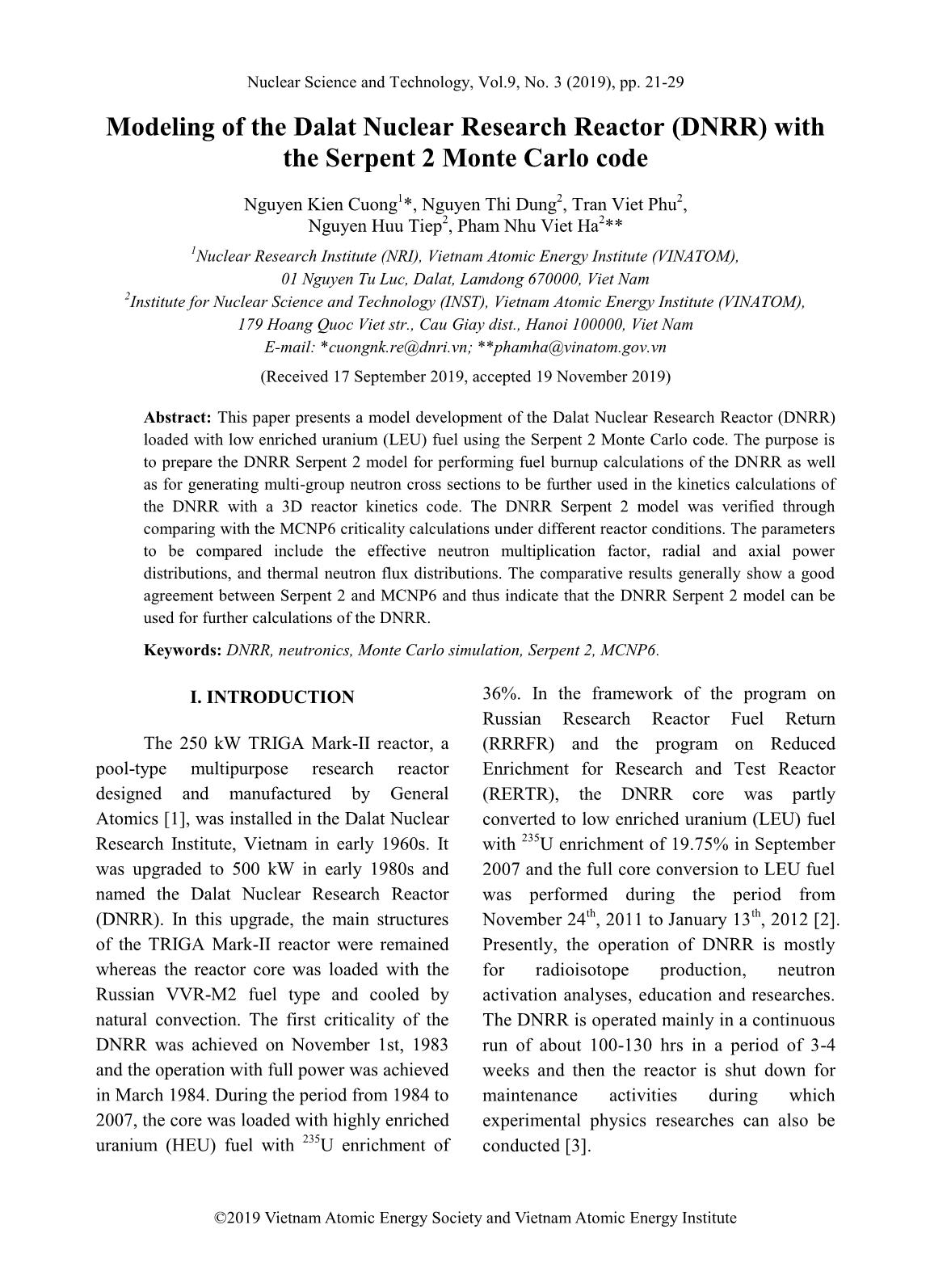
Trang 1
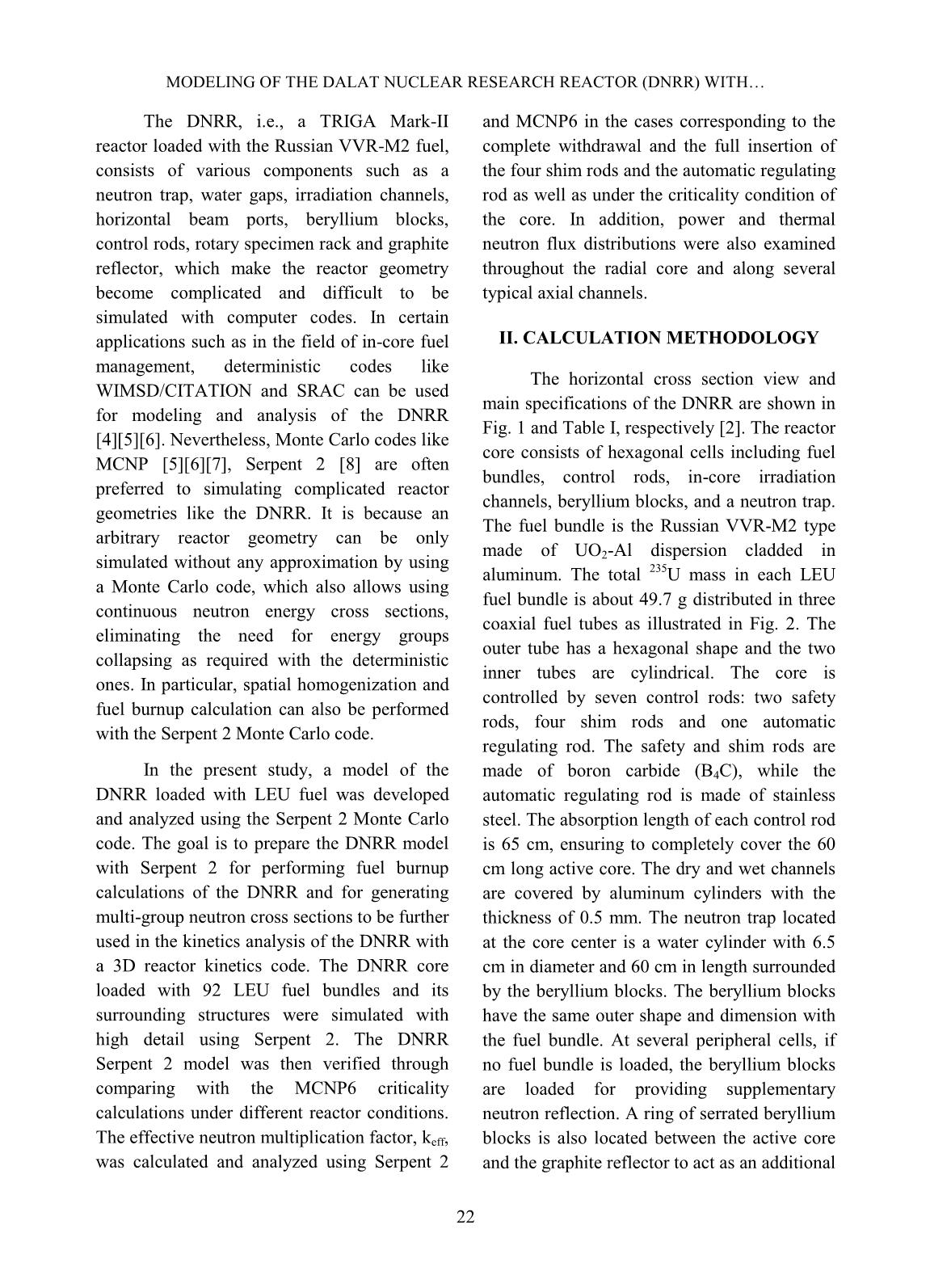
Trang 2
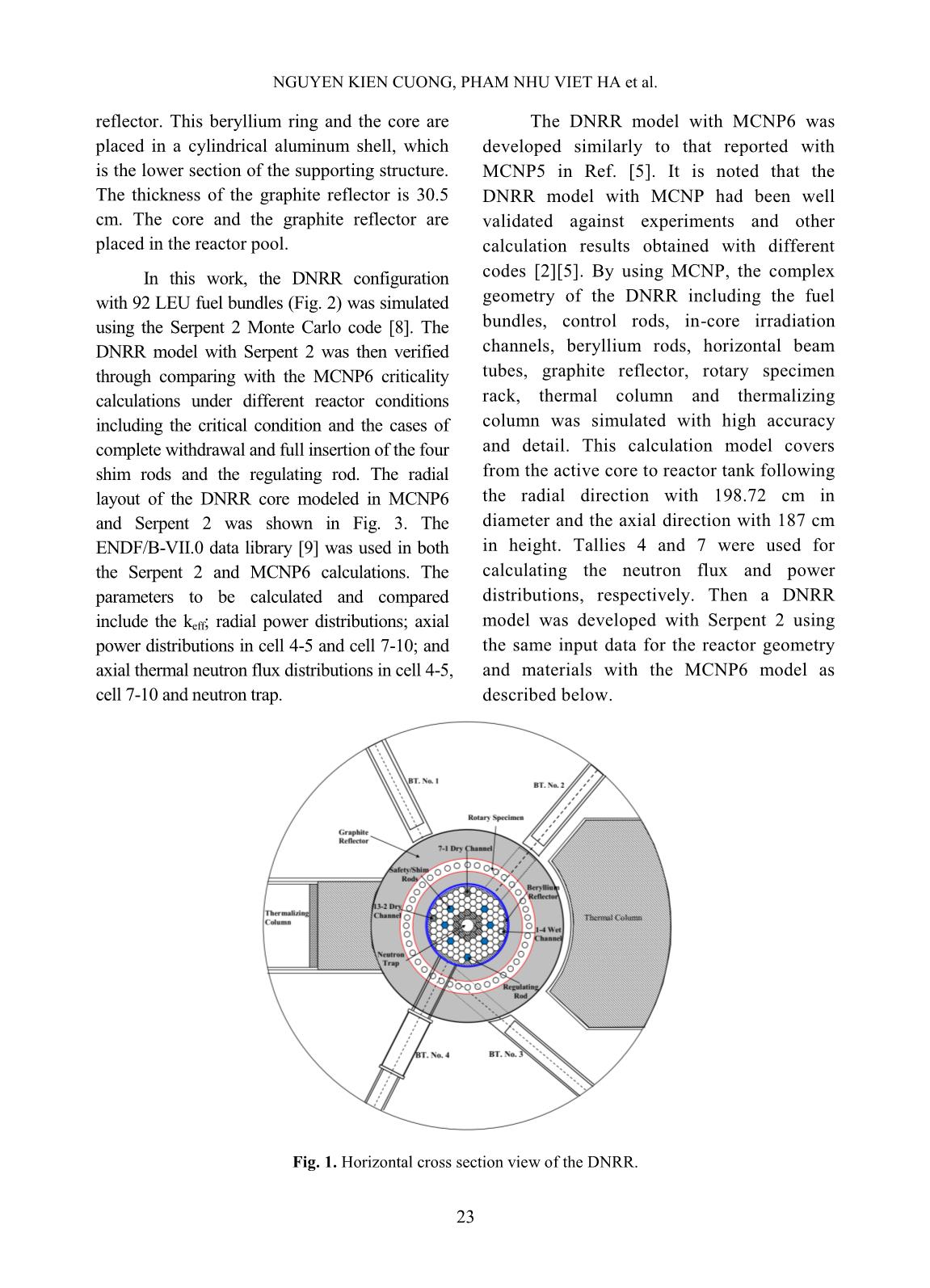
Trang 3
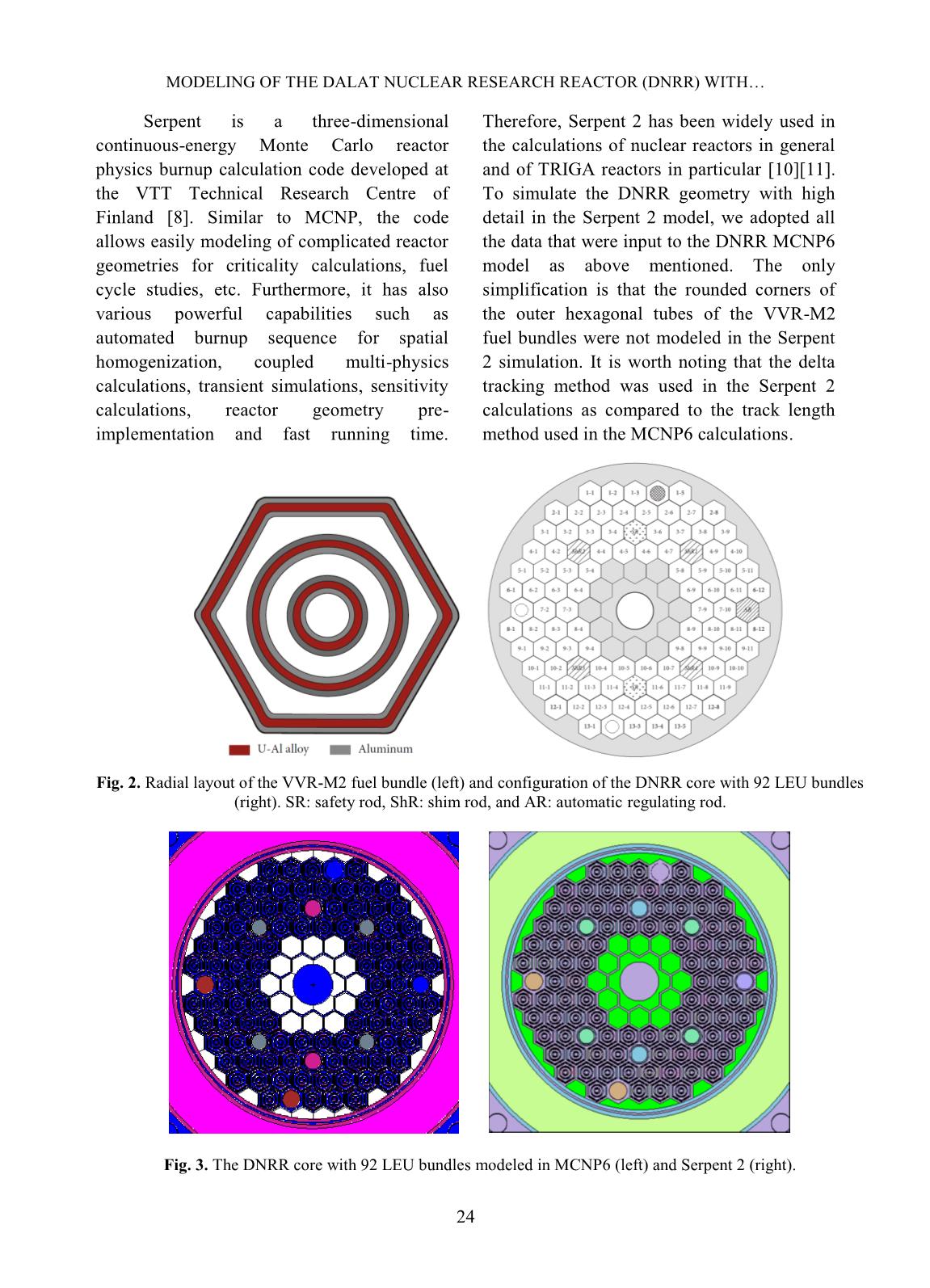
Trang 4
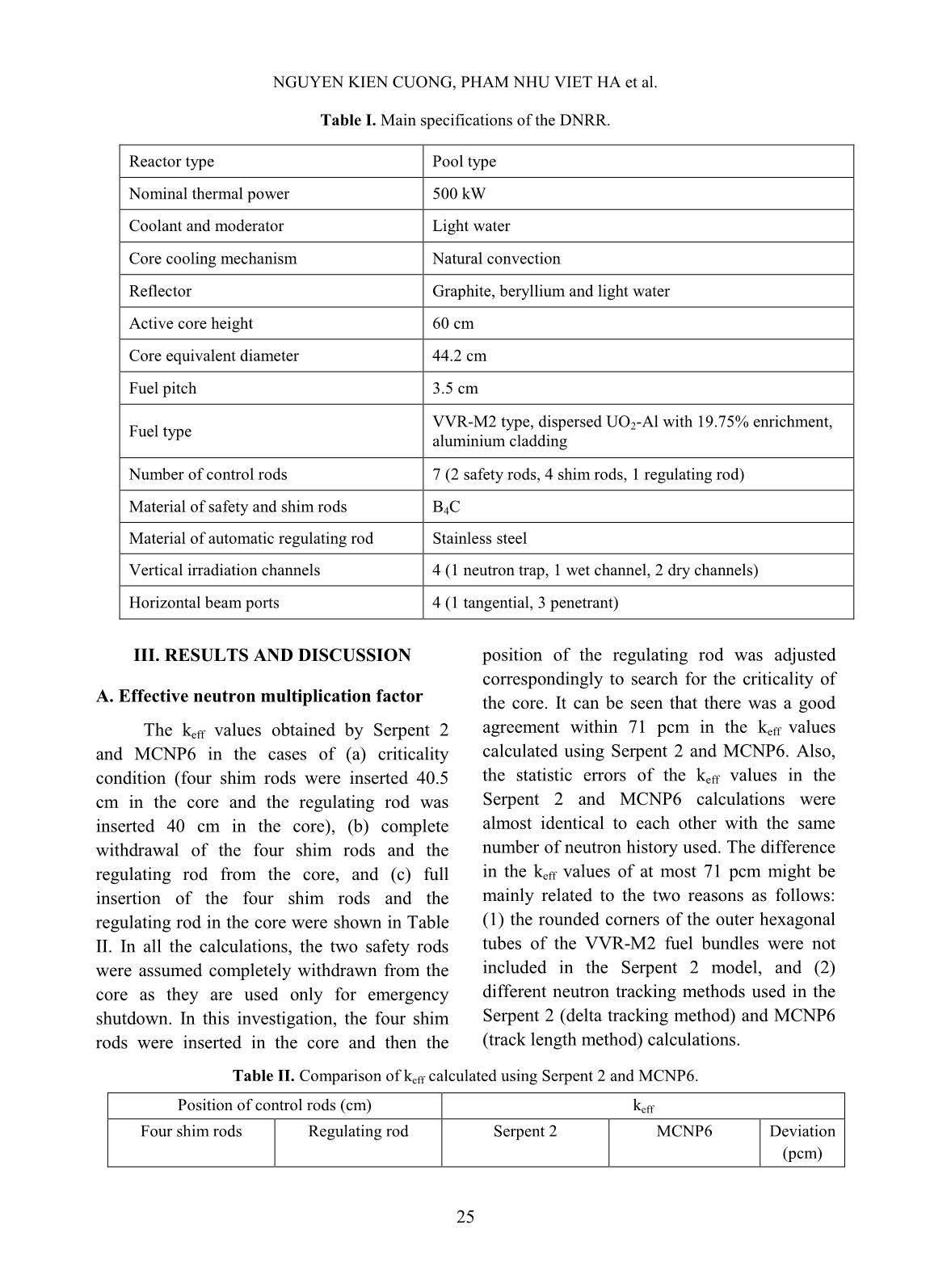
Trang 5

Trang 6
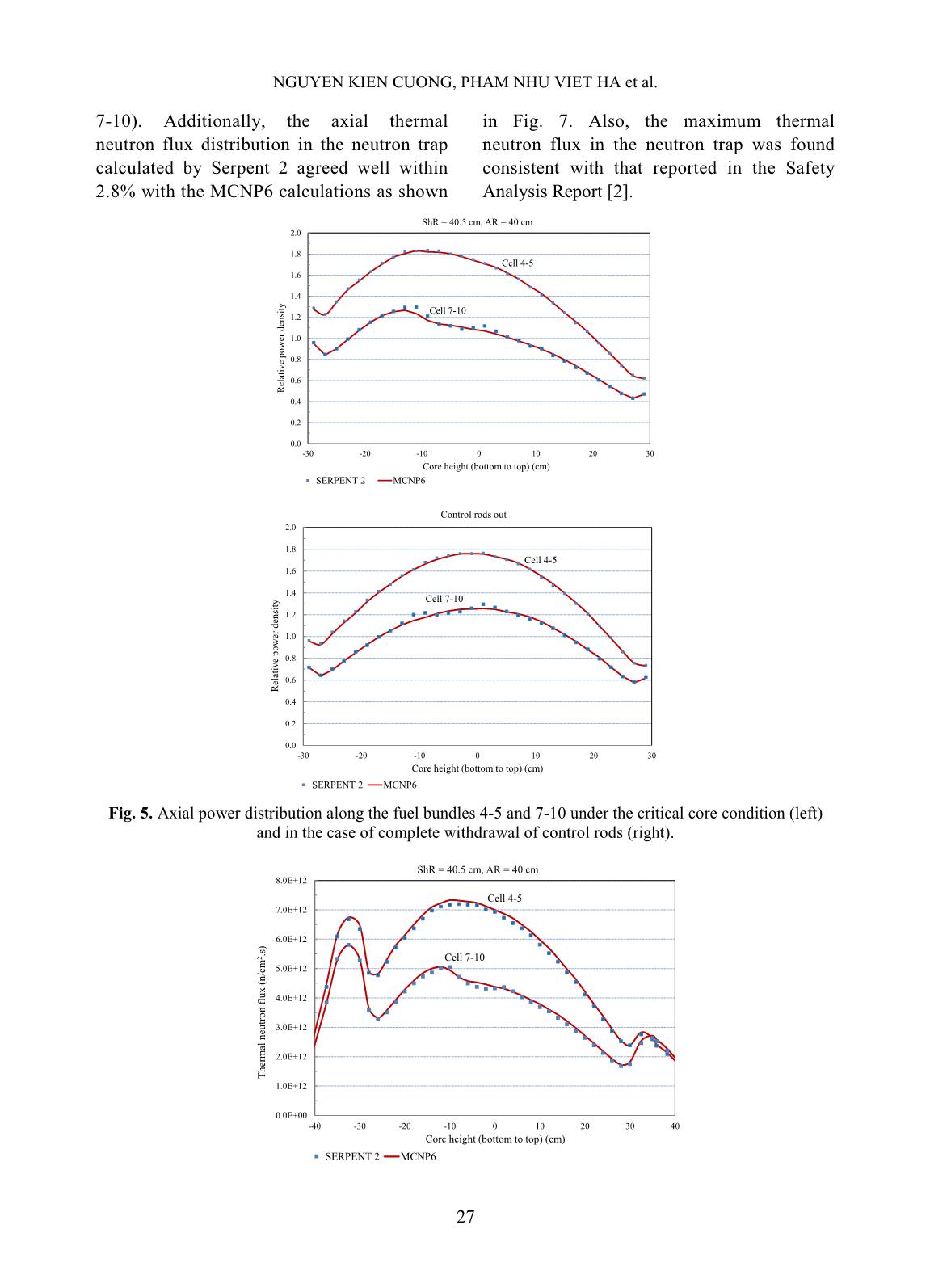
Trang 7
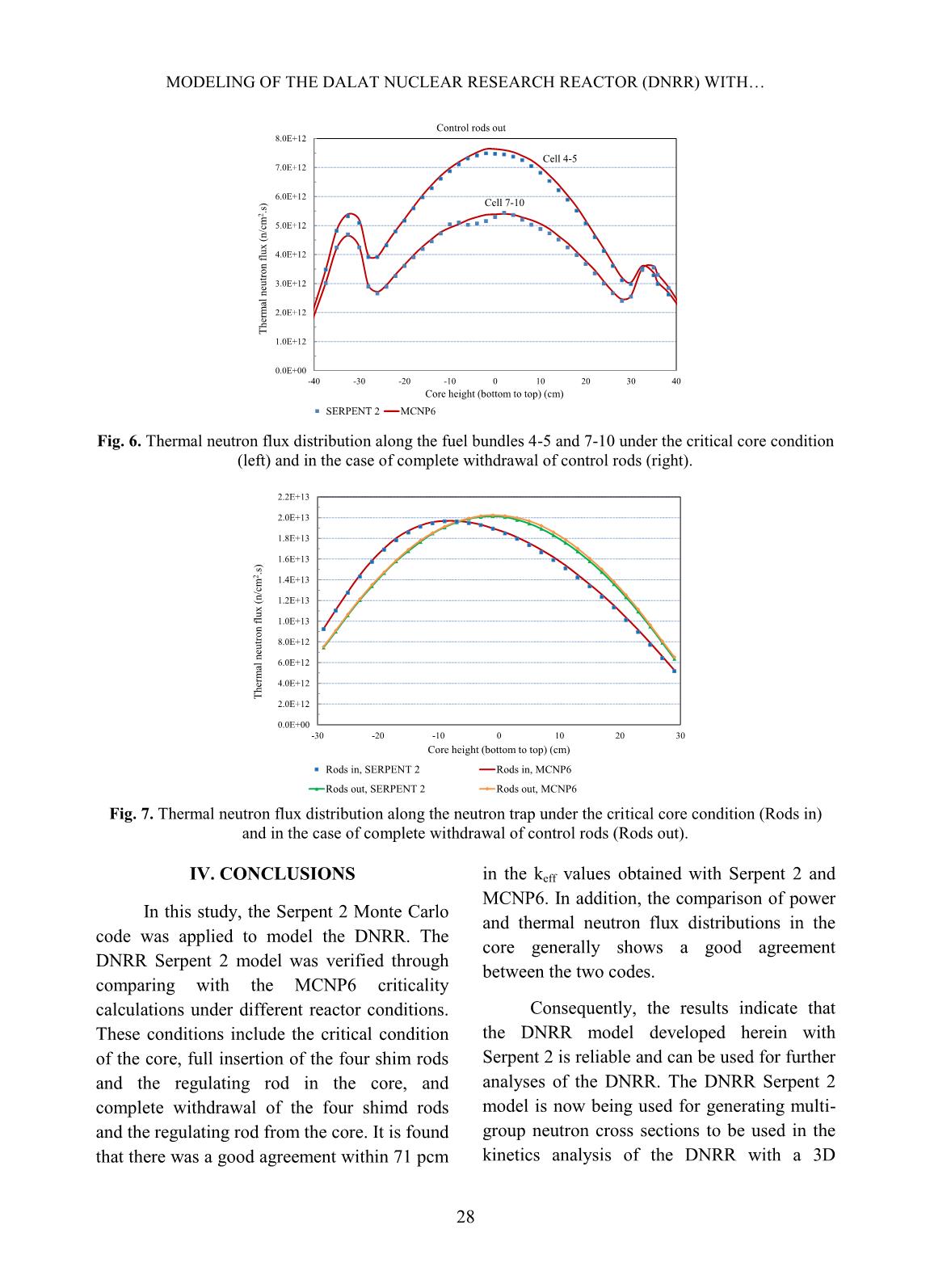
Trang 8
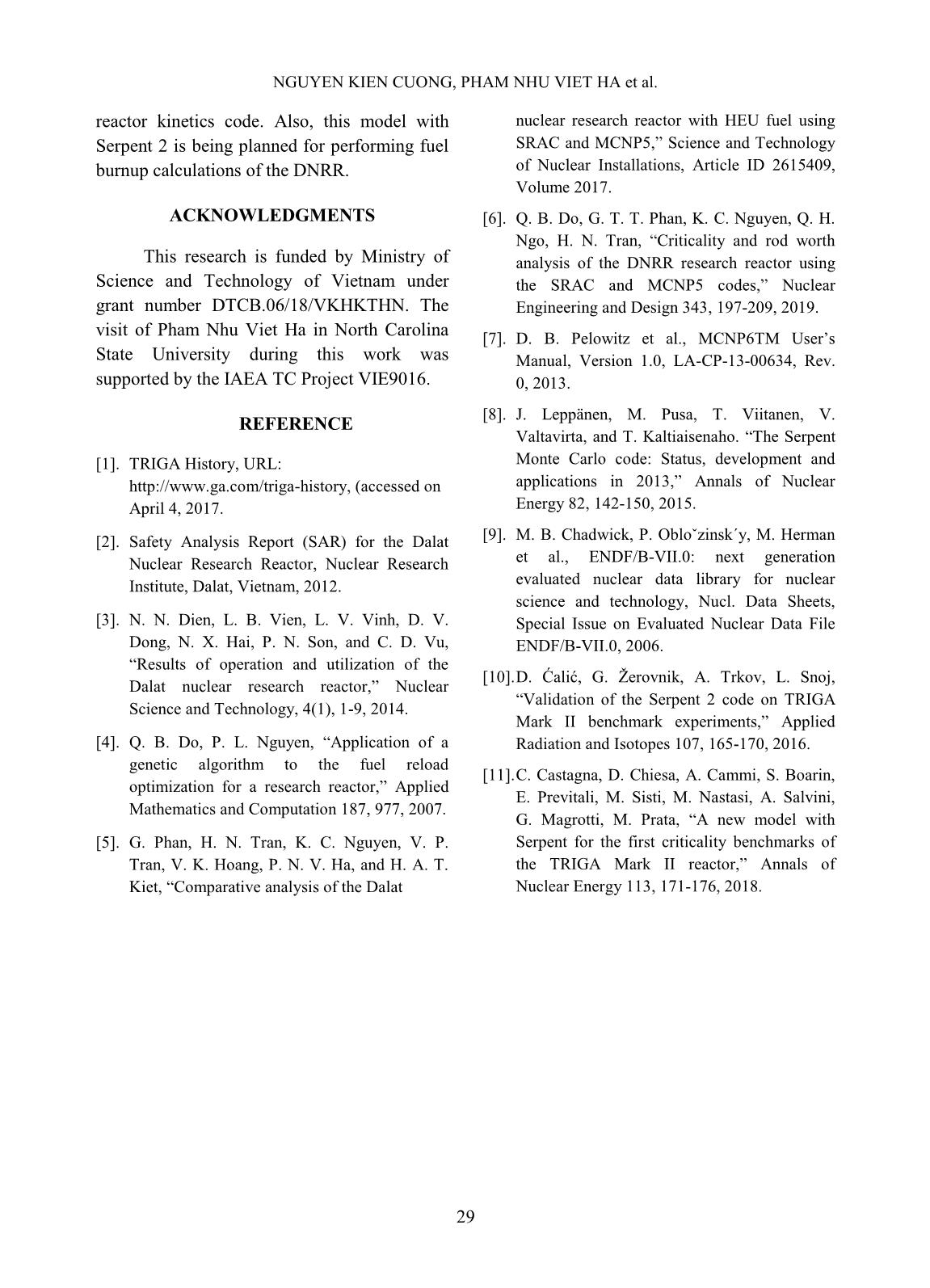
Trang 9
Tóm tắt nội dung tài liệu: Modeling of the Dalat Nuclear Research Reactor (DNRR) with the Serpent 2 Monte Carlo code
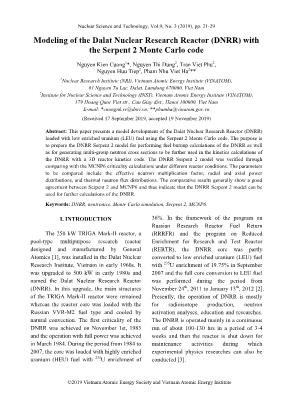
ks. The beryllium blocks have the same outer shape and dimension with the fuel bundle. At several peripheral cells, if no fuel bundle is loaded, the beryllium blocks are loaded for providing supplementary neutron reflection. A ring of serrated beryllium blocks is also located between the active core and the graphite reflector to act as an additional NGUYEN KIEN CUONG, PHAM NHU VIET HA et al. 23 reflector. This beryllium ring and the core are placed in a cylindrical aluminum shell, which is the lower section of the supporting structure. The thickness of the graphite reflector is 30.5 cm. The core and the graphite reflector are placed in the reactor pool. In this work, the DNRR configuration with 92 LEU fuel bundles (Fig. 2) was simulated using the Serpent 2 Monte Carlo code [8]. The DNRR model with Serpent 2 was then verified through comparing with the MCNP6 criticality calculations under different reactor conditions including the critical condition and the cases of complete withdrawal and full insertion of the four shim rods and the regulating rod. The radial layout of the DNRR core modeled in MCNP6 and Serpent 2 was shown in Fig. 3. The ENDF/B-VII.0 data library [9] was used in both the Serpent 2 and MCNP6 calculations. The parameters to be calculated and compared include the keff; radial power distributions; axial power distributions in cell 4-5 and cell 7-10; and axial thermal neutron flux distributions in cell 4-5, cell 7-10 and neutron trap. The DNRR model with MCNP6 was developed similarly to that reported with MCNP5 in Ref. [5]. It is noted that the DNRR model with MCNP had been well validated against experiments and other calculation results obtained with different codes [2][5]. By using MCNP, the complex geometry of the DNRR including the fuel bundles, control rods, in-core irradiation channels, beryllium rods, horizontal beam tubes, graphite reflector, rotary specimen rack, thermal column and thermalizing column was simulated with high accuracy and detail. This calculation model covers from the active core to reactor tank following the radial direction with 198.72 cm in diameter and the axial direction with 187 cm in height. Tallies 4 and 7 were used for calculating the neutron flux and power distributions, respectively. Then a DNRR model was developed with Serpent 2 using the same input data for the reactor geometry and materials with the MCNP6 model as described below. Fig. 1. Horizontal cross section view of the DNRR. MODELING OF THE DALAT NUCLEAR RESEARCH REACTOR (DNRR) WITH 24 Serpent is a three-dimensional continuous-energy Monte Carlo reactor physics burnup calculation code developed at the VTT Technical Research Centre of Finland [8]. Similar to MCNP, the code allows easily modeling of complicated reactor geometries for criticality calculations, fuel cycle studies, etc. Furthermore, it has also various powerful capabilities such as automated burnup sequence for spatial homogenization, coupled multi-physics calculations, transient simulations, sensitivity calculations, reactor geometry pre- implementation and fast running time. Therefore, Serpent 2 has been widely used in the calculations of nuclear reactors in general and of TRIGA reactors in particular [10][11]. To simulate the DNRR geometry with high detail in the Serpent 2 model, we adopted all the data that were input to the DNRR MCNP6 model as above mentioned. The only simplification is that the rounded corners of the outer hexagonal tubes of the VVR-M2 fuel bundles were not modeled in the Serpent 2 simulation. It is worth noting that the delta tracking method was used in the Serpent 2 calculations as compared to the track length method used in the MCNP6 calculations. Fig. 2. Radial layout of the VVR-M2 fuel bundle (left) and configuration of the DNRR core with 92 LEU bundles (right). SR: safety rod, ShR: shim rod, and AR: automatic regulating rod. Fig. 3. The DNRR core with 92 LEU bundles modeled in MCNP6 (left) and Serpent 2 (right). NGUYEN KIEN CUONG, PHAM NHU VIET HA et al. 25 Table I. Main specifications of the DNRR. Reactor type Pool type Nominal thermal power 500 kW Coolant and moderator Light water Core cooling mechanism Natural convection Reflector Graphite, beryllium and light water Active core height 60 cm Core equivalent diameter 44.2 cm Fuel pitch 3.5 cm Fuel type VVR-M2 type, dispersed UO2-Al with 19.75% enrichment, aluminium cladding Number of control rods 7 (2 safety rods, 4 shim rods, 1 regulating rod) Material of safety and shim rods B4C Material of automatic regulating rod Stainless steel Vertical irradiation channels 4 (1 neutron trap, 1 wet channel, 2 dry channels) Horizontal beam ports 4 (1 tangential, 3 penetrant) III. RESULTS AND DISCUSSION A. Effective neutron multiplication factor The keff values obtained by Serpent 2 and MCNP6 in the cases of (a) criticality condition (four shim rods were inserted 40.5 cm in the core and the regulating rod was inserted 40 cm in the core), (b) complete withdrawal of the four shim rods and the regulating rod from the core, and (c) full insertion of the four shim rods and the regulating rod in the core were shown in Table II. In all the calculations, the two safety rods were assumed completely withdrawn from the core as they are used only for emergency shutdown. In this investigation, the four shim rods were inserted in the core and then the position of the regulating rod was adjusted correspondingly to search for the criticality of the core. It can be seen that there was a good agreement within 71 pcm in the keff values calculated using Serpent 2 and MCNP6. Also, the statistic errors of the keff values in the Serpent 2 and MCNP6 calculations were almost identical to each other with the same number of neutron history used. The difference in the keff values of at most 71 pcm might be mainly related to the two reasons as follows: (1) the rounded corners of the outer hexagonal tubes of the VVR-M2 fuel bundles were not included in the Serpent 2 model, and (2) different neutron tracking methods used in the Serpent 2 (delta tracking method) and MCNP6 (track length method) calculations. Table II. Comparison of keff calculated using Serpent 2 and MCNP6. Position of control rods (cm) keff Four shim rods Regulating rod Serpent 2 MCNP6 Deviation (pcm) MODELING OF THE DALAT NUCLEAR RESEARCH REACTOR (DNRR) WITH 26 Full insertion Full insertion 0.97103 0.00007 0.97140 0.00006 -37 Complete withdrawal Complete withdrawal 1.07864 0.00007 1.07793 0.00005 71 40.5 40 1.00073 0.00007 1.00018 0.00006 55 B. Power and thermal neutron flux distributions In this Section, power and thermal neutron flux distributions were calculated and analyzed using Serpent 2 in comparison with the MCNP6 calculations. The two cases including the criticality of the core and complete withdrawal of the shim rods and the regulating rod as shown in Table II were considered. Fig. 4 displays the relative radial power distributions calculated by Serpent 2 and MCNP6. It can be seen that there was a good agreement between the two codes. The maximum difference in the radial power distributions calculated by Serpent 2 and MCNP6 in the cases was 6.2% (critical condition) and -5.7% (complete withdrawal of control rods), which appeared at the fuel bundles located in the periphery of the core. The maximum value of the relative radial power distribution was found at cell 4-5 in both cases. This value was 1.424 under the critical condition and 1.374 in case of complete withdrawal of control rods. Hence, the insertion of control rods under the critical condition increased the maximum value of the radial power distribution 3.6%. Fig. 4. Relative radial power distribution in the core under the critical condition (left) and in the case of complete withdrawal of control rods (right). The upper and lower values were obtained with Serpent 2 and MCNP6, respectively. The axial power and thermal neutron flux distributions in cell 4-5 and cell 7-10 were shown in Figs. 5-6. Cell 4-5 is the position at which the relative radial power was highest and cell 7-10 is the position next to the regulating rod, which can show clearly the effect of control rod insertion. Fig. 5 shows a good agreement between the axial power distributions obtained with Serpent 2 and MCNP6 in these two cells. The respective maximum difference between the codes was 1.5% (cell 4-5) and 4.9% (cell 7-10). Similarly, the axial thermal neutron flux distributions in cell 4-5 and cell 7-10 calculated by Serpent 2 compared well with those calculated by MCNP6 as shown in Fig. 6. The respective maximum difference between the codes in this case was 3.3% (cell 4-5) and -4.2% (cell NGUYEN KIEN CUONG, PHAM NHU VIET HA et al. 27 7-10). Additionally, the axial thermal neutron flux distribution in the neutron trap calculated by Serpent 2 agreed well within 2.8% with the MCNP6 calculations as shown in Fig. 7. Also, the maximum thermal neutron flux in the neutron trap was found consistent with that reported in the Safety Analysis Report [2]. Fig. 5. Axial power distribution along the fuel bundles 4-5 and 7-10 under the critical core condition (left) and in the case of complete withdrawal of control rods (right). 0.0 0.2 0.4 0.6 0.8 1.0 1.2 1.4 1.6 1.8 2.0 -30 -20 -10 0 10 20 30 R el at iv e p o w er d en si ty Core height (bottom to top) (cm) ShR = 40.5 cm, AR = 40 cm SERPENT 2 MCNP6 Cell 4-5 Cell 7-10 0.0 0.2 0.4 0.6 0.8 1.0 1.2 1.4 1.6 1.8 2.0 -30 -20 -10 0 10 20 30 R el at iv e p o w er d en si ty Core height (bottom to top) (cm) Control rods out SERPENT 2 MCNP6 Cell 7-10 Cell 4-5 0.0E+00 1.0E+12 2.0E+12 3.0E+12 4.0E+12 5.0E+12 6.0E+12 7.0E+12 8.0E+12 -40 -30 -20 -10 0 10 20 30 40 T h er m al n eu tr o n f lu x ( n /c m 2 .s ) Core height (bottom to top) (cm) ShR = 40.5 cm, AR = 40 cm SERPENT 2 MCNP6 Cell 4-5 Cell 7-10 MODELING OF THE DALAT NUCLEAR RESEARCH REACTOR (DNRR) WITH 28 Fig. 6. Thermal neutron flux distribution along the fuel bundles 4-5 and 7-10 under the critical core condition (left) and in the case of complete withdrawal of control rods (right). Fig. 7. Thermal neutron flux distribution along the neutron trap under the critical core condition (Rods in) and in the case of complete withdrawal of control rods (Rods out). IV. CONCLUSIONS In this study, the Serpent 2 Monte Carlo code was applied to model the DNRR. The DNRR Serpent 2 model was verified through comparing with the MCNP6 criticality calculations under different reactor conditions. These conditions include the critical condition of the core, full insertion of the four shim rods and the regulating rod in the core, and complete withdrawal of the four shimd rods and the regulating rod from the core. It is found that there was a good agreement within 71 pcm in the keff values obtained with Serpent 2 and MCNP6. In addition, the comparison of power and thermal neutron flux distributions in the core generally shows a good agreement between the two codes. Consequently, the results indicate that the DNRR model developed herein with Serpent 2 is reliable and can be used for further analyses of the DNRR. The DNRR Serpent 2 model is now being used for generating multi- group neutron cross sections to be used in the kinetics analysis of the DNRR with a 3D 0.0E+00 1.0E+12 2.0E+12 3.0E+12 4.0E+12 5.0E+12 6.0E+12 7.0E+12 8.0E+12 -40 -30 -20 -10 0 10 20 30 40 T h er m al n eu tr o n f lu x ( n /c m 2 .s ) Core height (bottom to top) (cm) Control rods out SERPENT 2 MCNP6 Cell 4-5 Cell 7-10 0.0E+00 2.0E+12 4.0E+12 6.0E+12 8.0E+12 1.0E+13 1.2E+13 1.4E+13 1.6E+13 1.8E+13 2.0E+13 2.2E+13 -30 -20 -10 0 10 20 30 T h er m al n eu tr o n f lu x ( n /c m 2 .s ) Core height (bottom to top) (cm) Rods in, SERPENT 2 Rods in, MCNP6 Rods out, SERPENT 2 Rods out, MCNP6 NGUYEN KIEN CUONG, PHAM NHU VIET HA et al. 29 reactor kinetics code. Also, this model with Serpent 2 is being planned for performing fuel burnup calculations of the DNRR. ACKNOWLEDGMENTS This research is funded by Ministry of Science and Technology of Vietnam under grant number DTCB.06/18/VKHKTHN. The visit of Pham Nhu Viet Ha in North Carolina State University during this work was supported by the IAEA TC Project VIE9016. REFERENCE [1]. TRIGA History, URL: (accessed on April 4, 2017. [2]. Safety Analysis Report (SAR) for the Dalat Nuclear Research Reactor, Nuclear Research Institute, Dalat, Vietnam, 2012. [3]. N. N. Dien, L. B. Vien, L. V. Vinh, D. V. Dong, N. X. Hai, P. N. Son, and C. D. Vu, “Results of operation and utilization of the Dalat nuclear research reactor,” Nuclear Science and Technology, 4(1), 1-9, 2014. [4]. Q. B. Do, P. L. Nguyen, “Application of a genetic algorithm to the fuel reload optimization for a research reactor,” Applied Mathematics and Computation 187, 977, 2007. [5]. G. Phan, H. N. Tran, K. C. Nguyen, V. P. Tran, V. K. Hoang, P. N. V. Ha, and H. A. T. Kiet, “Comparative analysis of the Dalat nuclear research reactor with HEU fuel using SRAC and MCNP5,” Science and Technology of Nuclear Installations, Article ID 2615409, Volume 2017. [6]. Q. B. Do, G. T. T. Phan, K. C. Nguyen, Q. H. Ngo, H. N. Tran, “Criticality and rod worth analysis of the DNRR research reactor using the SRAC and MCNP5 codes,” Nuclear Engineering and Design 343, 197-209, 2019. [7]. D. B. Pelowitz et al., MCNP6TM User’s Manual, Version 1.0, LA-CP-13-00634, Rev. 0, 2013. [8]. J. Leppänen, M. Pusa, T. Viitanen, V. Valtavirta, and T. Kaltiaisenaho. “The Serpent Monte Carlo code: Status, development and applications in 2013,” Annals of Nuclear Energy 82, 142-150, 2015. [9]. M. B. Chadwick, P. Obloˇzinsk´y, M. Herman et al., ENDF/B-VII.0: next generation evaluated nuclear data library for nuclear science and technology, Nucl. Data Sheets, Special Issue on Evaluated Nuclear Data File ENDF/B-VII.0, 2006. [10]. D. Ćalić, G. Žerovnik, A. Trkov, L. Snoj, “Validation of the Serpent 2 code on TRIGA Mark II benchmark experiments,” Applied Radiation and Isotopes 107, 165-170, 2016. [11]. C. Castagna, D. Chiesa, A. Cammi, S. Boarin, E. Previtali, M. Sisti, M. Nastasi, A. Salvini, G. Magrotti, M. Prata, “A new model with Serpent for the first criticality benchmarks of the TRIGA Mark II reactor,” Annals of Nuclear Energy 113, 171-176, 2018.
File đính kèm:
 modeling_of_the_dalat_nuclear_research_reactor_dnrr_with_the.pdf
modeling_of_the_dalat_nuclear_research_reactor_dnrr_with_the.pdf

